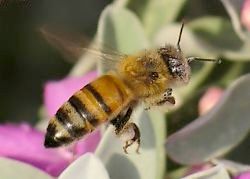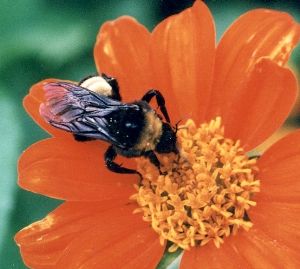Two Bees or Not
by Valerie (May 12, 2000)
revised August 12, 2003
 Our gardens almost always have plants flowering and so there are almost always bees. There are lots of different kinds, but the honeybees and bumblebees are the most noticeable. The honeybees (Apis mellifera) appear in groups, at about the same time each day, depending on what flower it is from which they are harvesting nectar and pollen. Since we don't have large numbers of any particular flower, the only times when the honeybees arrive in significant swarms are when certain trees are in blossom. When the sumacs or loquat bloom, the bees are so numerous that their buzzing is almost startling. Our gardens almost always have plants flowering and so there are almost always bees. There are lots of different kinds, but the honeybees and bumblebees are the most noticeable. The honeybees (Apis mellifera) appear in groups, at about the same time each day, depending on what flower it is from which they are harvesting nectar and pollen. Since we don't have large numbers of any particular flower, the only times when the honeybees arrive in significant swarms are when certain trees are in blossom. When the sumacs or loquat bloom, the bees are so numerous that their buzzing is almost startling.

Bumblebees (Bombus sp.), at the other extreme, are solitary as they make their rounds. They fly early in the morning, even when it is cold, since they can "warm" themselves up by vibrating their flight muscles until they reach a temperature at which they can fly. They don't seem to be very particular about which flowers they visit and check everything in the area.
|
